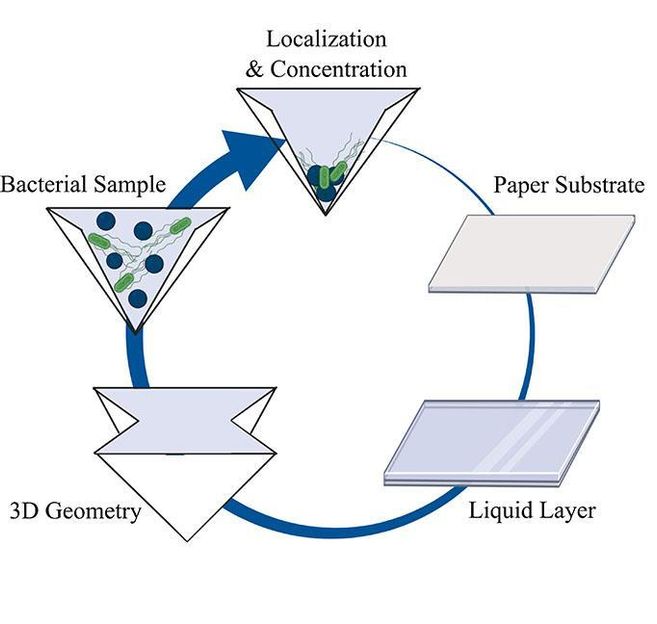Folded paper creates portable lab for field laboratory tests
Advertisement
Monitoring and tracking biological threats or epidemics require the ability to carry out medical and laboratory tests in the field during a disaster or other austere situations. Expensive laboratory equipment is often unavailable in these settings, so inexpensive point-of-care technology is needed.

This image is a achematic detailing the fabrication of liquid-infused polymer surfaces with 3D geometries to localize and concentrate bacterial samples.
Daniel Regan, University of Maine
Ordinary paper is often used in these situations, since it's cheap, portable and widely available. However, paper poses some problems that hinder its usefulness. In a issue of Biointerphases, from AIP Publishing, investigators from the University of Maine report a technique that greatly improves the performance of paper-based point-of-care technologies.
"Paper is a biodegradable resource that can help us address more future challenges than we think," co-author Caitlin Howell said.
In their research, the authors coated low-cost paper with a thin silicone polymer layer infused with a nontoxic silicone liquid and then folded the coated paper into precise geometries, creating vastly improved in-the-field devices for concentrating and testing biological samples. Although folded paper has been used in the past to create low-cost, portable field-testing equipment, it almost always relies on surface tension to move liquid through paper fibers.
Because these fibers vary widely in diameter and length, delivery of inconsistent volumes of fluid to the detector can occur, and losses of up to 50% of the fluid sample into the paper's pores are common. Also, paper pores are small, preventing the flow of large particles, such as blood cells and microbes, which significantly affects the accuracy of tests.
To address these issues, the coated paper creates a slippery overlayer that prevents biological materials, such as bacteria, from permanently sticking to the paper and allows droplets to slide off without leaving traces of fluid behind. It can be folded to create small cups to hold liquid samples.
The coated paper performed much more efficiently and reliably than dry, uncoated paper, regardless of the type of paper used, in terms of both the way the droplets evaporated and the way they easily slid off the paper.
Another test involved samples of live bacteria, E. coli and Staphylococcus aureus, placed into the paper cups and heated to concentrate and culture the samples. Coated paper performed much better than plain paper for E. coli, with nearly triple the number of bacteria in the coated-paper cups as compared to dry cups. Results for S. aureus were not quite as good, however, so further research will be needed.






















































